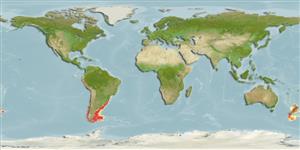Common names from other countries
Environment: milieu / climate zone / depth range / distribution range
Ecologie
Bathydemersaal. Tropical; 0°N - 90°S, 180°W - 180°E
Southeast Pacific and Southwest Atlantic: South America. Tropical to temperate.
Length at first maturity / Size / Gewicht / Leeftijd
Maturity: Lm ? range ? - ? cm Max length : 260 cm TL mannelijk/geslacht niet bekend; (Ref. 1394); 220 cm TL (female); Maximaal gepubliceerd gewicht: 350.0 kg (Ref. 1394); Maximaal gepubliceerd gewicht: 350.0 kg
Found over the continental shelf and slope. Occurs in deep waters, and also venture into freshwaters in rivers and around glaciers. Feeds on many species of benthic and pelagic fishes, and invertebrates (i.e. lobster, krill, squid, octopus, and jellyfish), and occasionally penguins and young South American seals) (Ref. 1394). Preyed upon by a sevengill shark (Ref. 8910). Found over the continental shelf and slope. Occurs in deep waters, and also venture into freshwaters in rivers and around glaciers. Feeds on many species of benthic and pelagic fishes, and invertebrates (i.e. lobster, krill, squid, octopus, and jellyfish), and occasionally penguins and young South American seals) (Ref. 1394).
Jefferson, T.A., S. Leatherwood and M.A. Webber. 1993. (Ref. 1394)
Status op de Rode Lijst van het IUCN (Ref. 130435)
Status bij CITES (Ref. 108899)
Not Evaluated
Gebruik door de mens
Visserij: commercieel
FAO - Visserij: landings, soortsprofiel | FishSource | Sea Around Us
Tools
Internet-bronnen
Estimates based on models
Preferred temperature
(Ref.
115969): 6.3 - 15.6, mean 9.9 (based on 922 cells).
Weerstandsvermogen
Hoog, minimale populatieverdubbelingstijd minder dan 15 maanden (K=0.31-0.31).
Kwetsbaarheid
Moderate to high vulnerability (51 of 100).
Prijsklasse
Unknown.
